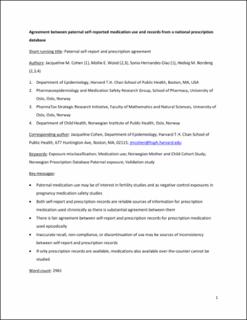| dc.description.abstract | PurposeFather's medication use is of interest in fertility studies and as negative control exposures in pregnancy medication safety studies. We sought to compare self-report to prescription records to understand how reliably each of these sources of information may be used. MethodsWe compared self-reported medication use in the 6 months prior to pregnancy from fathers participating in the Norwegian Mother and Child Cohort Study to records of dispensed prescriptions from the Norwegian Prescription Database that overlapped in time. Medications from 3 main categories were assessed: prescription medications used chronically, prescription medications used episodically, and over-the-counter/prescription medications (predominantly obtained without prescription). We calculated agreement between self-report and dispensing records using Cohen's kappa statistic. ResultsWe included 42848 pregnancies with the father's prescription data available for the 9 months before pregnancy. Prescription medications used chronically including antiepileptics, antipsychotics, and antidepressants showed substantial agreement between self-report and prescription records: kappa statistics 0.87, 0.63, and 0.74, respectively. Prescription medications used episodically like anti-infectives, opioids, anxiolytics, and hypnotics and sedatives showed worse agreement: kappa 0.19, 0.32, 0.40, 0.32. Over-the-counter/prescription medications like paracetamol and nonsteroidal anti-inflammatory drugs had slight agreement: kappa 0.02 and 0.20. ConclusionsThere is good agreement between paternal self-report and prescription data for prescribed medications used chronically and substantially less for medications used episodically. Suboptimal agreement for episodic medications suggests poor recall (for questionnaires) or false positives due to noncompliance (prescription data). Not surprisingly, use of medications available both with and without a prescription is not well captured using prescription databases alone. | |
